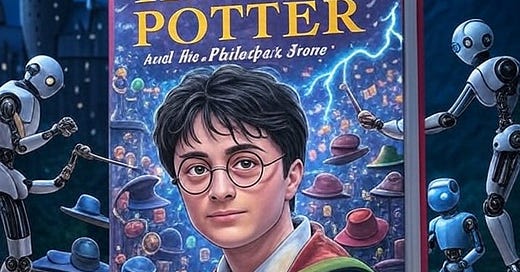Recently, the original drawing for the cover of J.K. Rowling’s first book, Harry Potter and the Philosopher’s Stone, sold for a staggering $1.9 million. This event not only reflects the enduring popularity of the Harry Potter saga but also highlights the extraordinary economic value that can emerge from a powerful idea. What began as a simple sketch has evolved into a symbol of how creativity can transform into a monumental economic force.
From an Idea to a Billion-Dollar Empire
The world of Harry Potter, born from J.K. Rowling’s imagination, is a fascinating example of how an idea can generate millions of dollars practically from nothing. From its humble beginnings as a story written in a café, the saga has sold over 500 million copies of its seven books worldwide, translated into 80 languages. The eight films based on these works have grossed more than $7.7 billion at the box office. Add to this merchandising products, theme parks like those at Universal Studios, and a stage play, Harry Potter and the Cursed Child. This entire economic empire, which has created jobs and opportunities globally, originated in the mind of a single person, demonstrating the limitless potential of human imagination.
The Economy as a Product of Creation
The economy is not just about producing physical goods or optimizing processes; it is also a space where ideas and creativity can generate value exponentially. The art of J.K. Rowling or J.R.R. Tolkien, with The Lord of the Rings and The Hobbit, illustrates this principle perfectly. These authors didn’t just create stories—they crafted infinite worlds that have captured the imaginations of millions. The Harry Potter franchise has generated over $25 billion, while Tolkien’s exceeds $19 billion. These figures rival, and in some cases surpass, the projected value of technological industries like artificial intelligence (AI), robotics, and humanoid robots. For example, the global AI market is estimated at $190 billion for 2025, an impressive figure, but one that pales in comparison to the sustained economic impact of these artistic works over time.
Imagination and Technology: An Explosive Combination
However, instead of viewing human creativity and technology as competitors, we can envision a future where they complement each other. AI tools, combined with human imagination and robotics, have the potential to unleash a true economic boom for all of humanity. AI can accelerate the visualization of ideas, enabling artists to create more detailed and complex worlds in less time, using technologies like generative design or virtual reality. Robotics, meanwhile, can bring those visions to life, from hyper-realistic animatronics in theme parks to interactive experiences that bring these universes closer to the public. For instance, AI could generate new adventures in the Harry Potter universe, while advanced robots could bring magical creatures to life in physical settings. This fusion would not only enrich art but also create new industries and jobs, benefiting the global economy.
The True Value of Ideas
The sale of the Harry Potter and the Philosopher’s Stone cover drawing for $1.9 million is much more than a transaction; it is a reminder of the transformative power of imagination. The economy thrives when fueled by creativity, and the worlds of Rowling and Tolkien prove that ideas can generate as much or more value than the most advanced technological innovations. By integrating human imagination with tools like AI and robotics, we stand on the brink of a future where economic potential knows no bounds. Ultimately, a good story, well told, remains one of the most powerful forces for moving the world.











Share this post